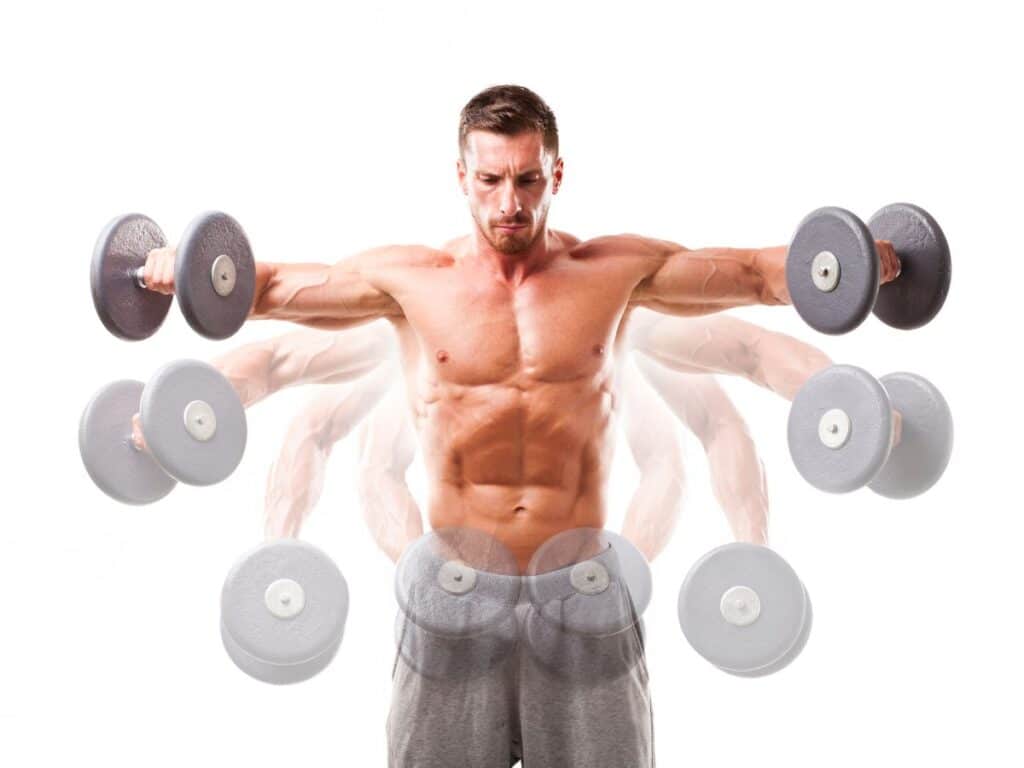For fitness enthusiasts searching for dynamic workouts that truly make a difference, the dumbbell shoulder fly is a potent addition to any strength training regimen.
This versatile exercise does a brilliant job targeting and toning the key muscles of your upper body, making it a crowd favorite in the gym.
However, the beauty of the dumbbell shoulder fly isn’t limited to just its muscle sculpting potential.
From bolstering your shoulder mobility to refining your body’s overall symmetry, this move truly has an impressive array of benefits waiting to be discovered.
Whether you’re a gym rookie testing the waters or a seasoned lifter looking for an edge, you might find yourself asking:
- What muscles does the dumbbell shoulder fly target?
- How can it elevate your fitness game?
- And most importantly, how can you perform this exercise with the right form and technique?
Buckle up as we dive deep into everything there is to know about the dumbbell shoulder fly.
We’ll break down the muscles worked, share the awesome benefits it can offer, and arm you with handy tips to help you master this exercise.
Muscles Worked

Before I add anything new to my fitness routine, I like to know how it’s going to benefit me.
So let’s look at the muscles that are primarily targeted and also supported by the dumbbell shoulder fly exercise.
Primary Muscles
The dumbbell shoulder fly primarily targets the pectoral muscles in the chest.
This exercise specifically works the pectoralis major, which has two main parts – the clavicular head (upper chest) and the sternal head (lower chest).
By performing dumbbell flyes, you can effectively engage the entire chest muscle group, leading to improved definition and strength in these muscles.
Supporting Muscles
While the pectoral muscles are the main focus of the dumbbell shoulder fly, there are supporting muscles that also play a role during the exercise.
The deltoid muscles in the shoulders are engaged to provide stability to the movement.
Additionally, the triceps and biceps in the arms assist in controlling the weight throughout the range of motion.
The end result here is that you can build a stronger, more defined upper body thanks to dumbbell shoulder flyes.

Benefits of Dumbbell Shoulder Fly
One of the main benefits I’ve experienced with dumbbell shoulder flys is the impact it has on my deltoid muscles.
The exercise specifically targets the middle fiber of the deltoid, which is crucial in developing that sought-after rounded 3D look for broader shoulders.
In addition to the middle fiber, the anterior deltoid is also engaged during the movement, further enhancing shoulder stability and strength.
You can also target the rear delt muscles with a reverse dumbbell fly.
Another advantage I’ve noticed is the improvement in my lifting ability in everyday life.
By working the different regions of my deltoids with this exercise, I’ve increased my overall shoulder strength, making it easier to carry and lift heavy objects.
As a fitness expert, I cannot emphasize enough the importance of strong and stable shoulders.
Incorporating dumbbell shoulder flys into my routine has significantly contributed to my upper body strength, providing a solid foundation for other upper body exercises and movements.
Not only has this exercise benefited my workout performance, but it has also impacted my posture positively, giving me a more confident and upright stance.
It’s a great shoulder workout routine for anyone seeking strong shoulders, good upper body training, and better posture.
Just remember that ensuring you’re maintaining the correct form and technique throughout each repetition is key to reaping these benefits and avoiding injury when adding this to your training program.
With a focus on controlled movements and consistent progress, dumbbell shoulder flys can be an excellent addition to any fitness enthusiast’s workout routine.
They are versatile and can be performed using various equipment, such as stability balls, to engage additional muscle groups and further challenge my strength and stability.
Proper Form and Technique
When it comes to performing the dumbbell shoulder fly, proper form and technique are crucial for ensuring you’re targeting the right muscles while also avoiding any risk of injury.
And I’ve got the tips to help you nail this exercise.
You’ll wanna start out by standing with your spaced feet shoulder-width apart and with a dumbbell in each hand.
Your palms should be facing inwards towards each other.

Make sure that you’re keeping your knees slightly bent as you do this movement.
Then initiate movement by raising your arms out to the sides, maintaining that slight bend in the elbow.
As you lift those weights, you gotta focus on squeezing those shoulder blades together while also making sure to keep your chest lifted and your back flat.
Note: It’s essential to avoid any jerking motions or using momentum to lift the weights – slow and steady is key.
At the top of the movement, your arms should be roughly parallel to the floor.

Lower the dumbbells back down to the starting position in a controlled manner, doing your best to resist gravity on the way down.
Remember that proper form trumps the amount of weight lifted, so it’s vital to choose weights that allow you to perform the exercise with the correct technique.
A few tips to keep in mind while performing the Dumbbell Shoulder Fly include:
- Try to keep your shoulders down and back, avoiding any upward shrugging motions.
- Ensure your wrists remain neutral and in line with your forearms, instead of bending them.
- Maintain a stable core throughout the movement, which not only helps with balance but also protects the lower back.
- Breathe properly – exhale as you lift the weights and inhale as you lower them.
5 Variations and Alternatives Of The Dumbbell Shoulder Fly
I always recommend trying different variations and alternatives to the dumbbell shoulder fly to keep your workouts interesting and prevent plateaus.
Dumbbell Reverse Fly
One variation is the Dumbbell Reverse Fly.

It targets the rear shoulders and major muscles of the upper back.
To perform this exercise, hold a pair of dumbbells in your hands and stand with your feet shoulder-width apart.
Then hinge forward from your hips.
As you do this, you gotta keep your back straight and those arms slightly bent, then raise the weights out to the sides while squeezing your shoulder blades together.
Cable Fly
Another alternative is the Cable Fly.

This exercise primarily targets the pectoral muscles, front deltoids, and triceps.
When you use a cable machine instead of a pair of dumbbells, you can maintain consistent resistance throughout the movement, leading to greater muscle activation.
To perform a cable fly, adjust the cable machine to chest height, grab the handles, and stand with one foot slightly forward.
Then, pull the handles towards the center of your chest while making sure to keep your arms straight and elbows slightly bent.
Other Alternatives
Here are more dumbbell fly alternatives:
- Floor Chest Fly: Similar to the classic dumbbell fly, but performed on the floor to limit the range of motion and also to reduce the risk of shoulder injury.
- Slider Push-Up: A push-up variation that utilizes sliders or towels on the floor to engage the chest and shoulders. The movement resembles a dumbbell fly.
- Plate Pinch Press: Holding a weight plate with both hands, press it against your chest and extend your arms fully, then bring it back to your chest. This exercise emphasizes the inner chest muscles.

Don’t be afraid to switch up your routine and try these variations and alternatives to the dumbbell shoulder fly to keep your muscles engaged and continue progressing in your fitness journey.
Common Mistakes to Avoid
When performing dumbbell shoulder flys, it’s important to be aware of common mistakes that can not only hinder progress but also put our bodies at risk of injury.
Too Much Weight
One common mistake I often see is using too heavy of a weight.
While it’s important to challenge ourselves, selecting a weight that’s too heavy can compromise our form and lead ultimately to strains or injuries from those heavy dumbbells.
To avoid this, choose a weight that allows you to maintain proper form and complete the desired number of repetitions with light dumbbells.
It’s okay if you have to use lighter weights because over time you can work up to heavier weights.
Locked Arms
Another mistake is locking out the arms during the movement.
Locking out the arms can place unnecessary stress on the elbows and shoulder joints, shifting the focus away from the target muscles.
To avoid this, maintain a slight bend in your elbows throughout the exercise, ensuring that your pecs – not your joints – are doing the work.
Bad Posture
Poor posture is another mistake that’s easy to make, especially when we’re concentrating on the weight and the movement.
It’s essential to keep your back flat and your neck in a neutral position while you’re doing the exercise to minimize the risk of injury.
For the ladies, not wearing a good sports bra can result in bad form, so get yourself a good women’s sports bra.
If you find it challenging to maintain proper posture, try performing the exercise in front of a mirror to monitor your form.
Being In A Hurry
Rushing through the exercise is also a common mistake.
Performing the dumbbell shoulder fly too quickly doesn’t allow our muscles the time to engage fully, which might negatively impact our results.
To make sure we maximize the benefits of this exercise, focus on maintaining a slow and controlled tempo while lifting and lowering the dumbbells.
6 Tips for Maximizing Your Dumbbell Shoulder Flyes Workout
In order to get the most out of your dumbbell shoulder fly exercise, here are a few essential tips I recommend:

- Warm up beforehand: Just like with any workout, it’s important to warm up properly before targeting your muscles. Spend 5-10 minutes on dynamic stretching and light cardio to get your blood flowing and loosen up those joints.
- Focus on proper form: During the dumbbell shoulder fly, maintain a slight bend in your elbows and avoid locking them out. Engage your core to keep your lower back supported, and make sure you lean your torso forward about 45 degrees to isolate the deltoid muscles effectively.
- Choose the right weight: Select a weight that is challenging but manageable. If you’re struggling to complete the exercise with proper form, consider decreasing the weight. On the other hand, if the exercise feels too easy, increase the weight to keep your muscles challenged.
- Control your movements: As you perform the dumbbell shoulder fly, focus on slow, controlled movements. This will help ensure you’re working the targeted muscles and avoiding potential injury caused by momentum or poor form.
- Incorporate a variety of exercises: While dumbbell shoulder flyes are great for targeting the deltoids, it’s essential to include other shoulder exercises in your routine as well. Make sure your workout plan incorporates pressing and pulling movements to engage all parts of the shoulder.
- Prioritize recovery: As with any workout, recovery is key to optimizing muscle growth and avoiding injury. Incorporate rest days into your schedule, practice proper nutrition and hydration, and stretch after each workout to keep your muscles limber and ready for your next session.
FAQs About Dumbbell Shoulder Flys
Here’s a quick look at the most common questions people have about the dumbbell shoulder fly.
What muscles are targeted by dumbbell shoulder flys?
When performing dumbbell shoulder flys, the primary muscles targeted are the lateral deltoid and anterior deltoid.
The lateral deltoid is the middle fiber of the deltoid muscle, and the anterior deltoid is the front part of the shoulder muscle.
The exercise also engages the upper chest muscles and the trapezius.
What are the benefits of incorporating shoulder flys into a workout routine?
Incorporating shoulder flys into a workout routine can improve shoulder strength, stability, and flexibility.
These exercises help develop a more rounded, 3D look of the shoulders and can enhance the lifting ability in everyday life.
Additionally, shoulder flyes can improve posture and reduce the risk of shoulder injuries by strengthening the stabilizing muscles.
How does a seated shoulder fly differ from a lateral raise?
A seated shoulder fly involves raising the dumbbells from a position near the front of the body, while keeping the arms slightly bent throughout the movement.

In contrast, a lateral raise begins with the dumbbells at the sides of the body and involves raising them out to the side while keeping the arms straight.
Both exercises primarily target the lateral deltoid, but the seated shoulder fly also engages the anterior deltoid to a greater extent.
What is the proper form for executing a front shoulder fly?
To execute a front shoulder fly with proper form, start by standing with feet shoulder-width apart while holding dumbbells in front of your thighs with palms facing inward.
Keeping a slight bend in those elbows, raise the dumbbells up to shoulder height in a controlled manner, while maintaining a neutral grip.
Slowly lower your dumbbells back to our starting position, repeating for the desired number of repetitions.
What muscles are engaged during a reverse shoulder fly?
During a reverse shoulder fly, the primary muscles engaged are the posterior deltoid, the rear part of the shoulder muscle or rear delt, and the trapezius.
This exercise helps to balance shoulder development, ensuring that the back of the shoulder is not neglected in your training.
Are there any tips for performing dumbbell shoulder exercises effectively?
Ensure that you are using appropriate weights for your current fitness level.
Focus on controlled, slow movements throughout the exercise to maximize muscle engagement.
Be mindful of your posture, keeping your back straight and chest up.
And remember to breathe correctly, exhaling when you lift the weight and then inhaling as you lower it.
Is a reverse fly for back or shoulders?
While a reverse fly primarily targets the posterior deltoid (rear deltoid) in the shoulders, it also engages the upper back muscles, particularly the trapezius and rhomboids.
So, it can be considered a combined exercise for both the back and shoulders, providing excellent overall upper body muscle development.
